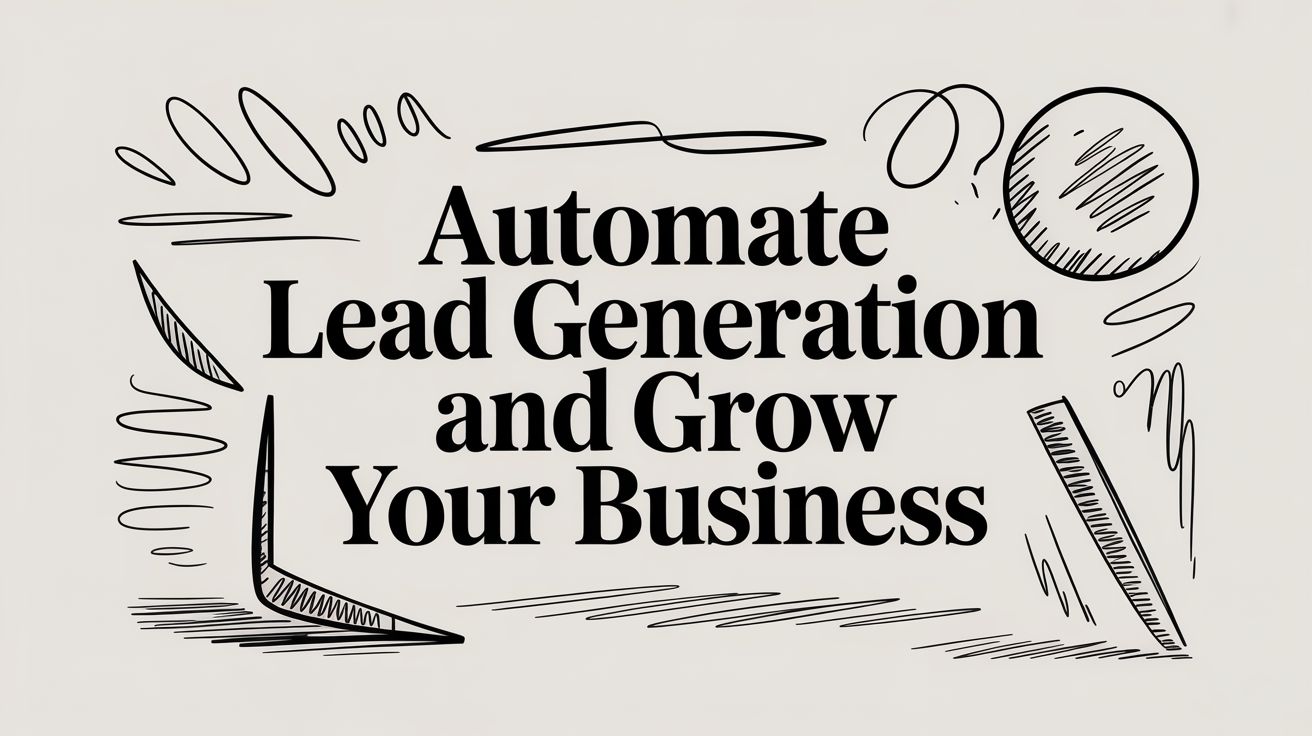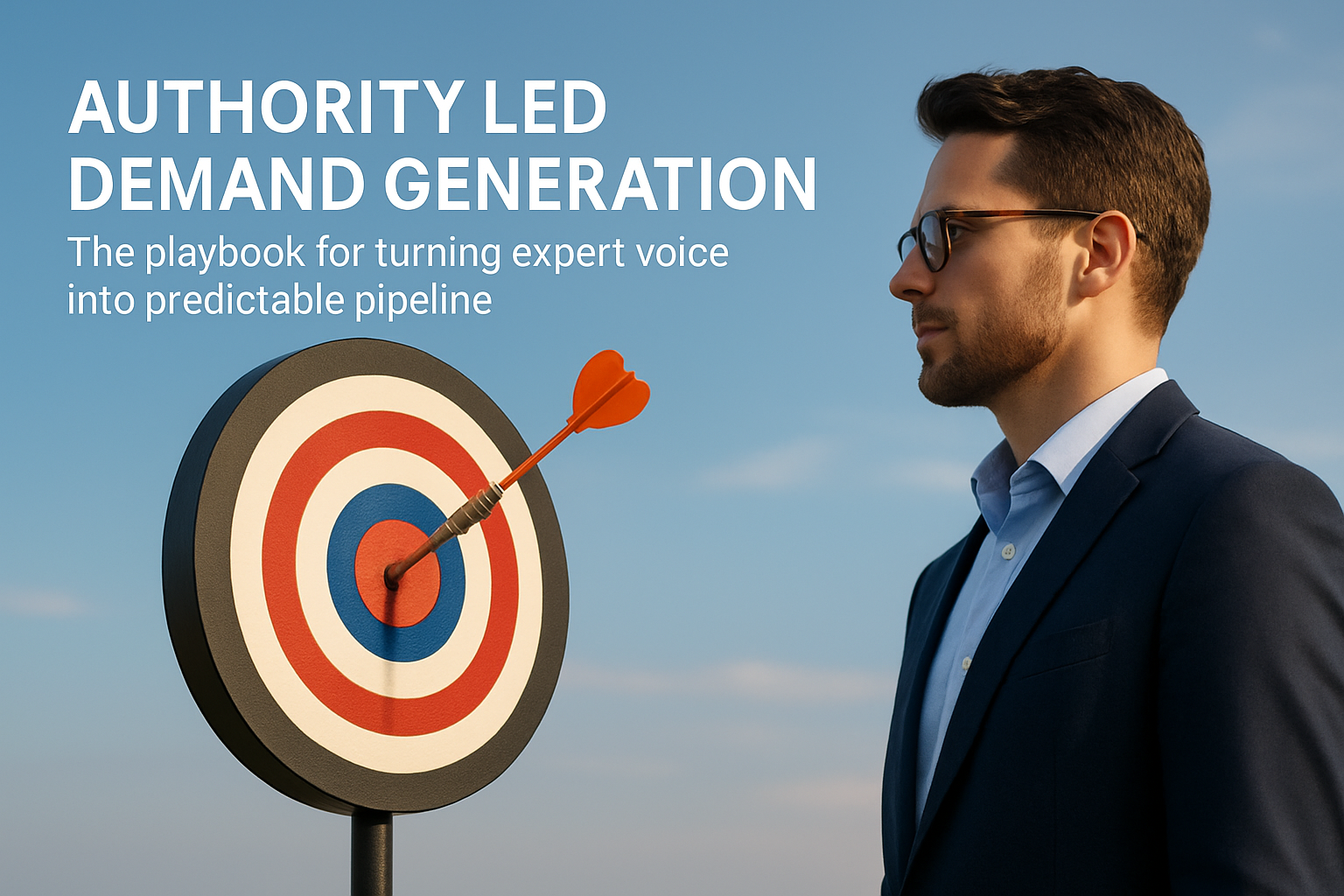Make Finding Customers Easy and Grow Your Business

So what does it mean to automate lead generation? It’s just a fancy way of saying you use computer programs to do the boring, repetitive work of finding new customers. Think of it like building a little robot that works for you all day and all night. This robot finds people who might want what you sell, so you can spend your time actually talking to them and making sales.
Why Your Business Needs a Customer-Finding Machine
Imagine you have to fill a giant swimming pool, but all you have is a tiny bucket. You’d run back and forth, getting super tired, and it would take forever! That’s what trying to find customers by hand feels like. It's a lot of hard work for just one or two people.
Now, what if you could just turn on a hose and walk away? That's what it’s like when you automate lead generation. You set up a smart system one time, and it keeps bringing interested people to you.
This isn't just for huge companies with tons of money. Nope. It’s actually even more important for smaller businesses. And it really works! Did you know that 80% of businesses that use these kinds of robot helpers see more people knocking on their door? It's true!
What's the Real Goal Here?
Let’s get one thing straight: this isn't about being lazy. It’s about being smart! When you let the robots do the boring stuff that makes your brain hurt, you have more energy for the important things. Like actually building relationships with people.
A good robot system can do stuff like:
- Get people to your website while you’re fast asleep.
- Grab their email address by giving them something cool for free.
- Send a nice "hello" email the moment they sign up.
- Keep sending them helpful tips so they start to trust you.
By the time you talk to these people, they’re not strangers. They already know you! It turns a frustrating chase into a friendly welcome.
The real magic happens when you mix the robot work with your human touch. The robot does the heavy lifting, so you can have real chats with people who are actually excited to hear from you.
This guide is your map. We're going to show you, step-by-step, how to build your very own customer-finding machine. It's time to stop chasing and start attracting.
The Steps of a Customer-Finding Machine
To see how it all works, let's break it down into simple steps. Each step has one job, and they all work together to turn a stranger into a happy lead.
Here's a little chart to show you the journey:
| Step | What It Does | A Tool You Can Use |
|---|---|---|
| Finding People | Grabs the attention of the right people by answering their questions on Google or social media. | Ahrefs helps you see what people search for. |
| Saying Hello | Turns visitors into friends by offering a free gift in exchange for their email. | A special webpage made with a tool like Unbounce. |
| Sorting Friends | Automatically figures out who is a really good fit for what you sell. | Smart tools like HubSpot or ActiveCampaign. |
| Making Friends | Builds trust by sending helpful emails over time. | A series of friendly emails. |
| Booking a Chat | Makes it super easy for interested people to schedule a call with you. | A scheduler like Calendly. |
Knowing these steps is the first part of the puzzle. Now, let's figure out how to build each one!
Getting the Right People to Come to You
I always think of this like a cooking show. You can have the best kitchen in the world, but if nobody shows up to eat, what's the point? The best ingredients for your business are the right kind of people. The trick is to get them to find you without you having to chase them down.
Your website and your LinkedIn page are like your front door. You don't need to play tricks to get people there. You just need to be super helpful. When you do that, the right people just... show up. It’s pretty cool.
Talk Like a Real Person
So many businesses use big, confusing words. They say things like "synergistic workflows" when their customers are just typing "how to get my team to work together" into Google. Weird, right?
To make your customer-finding machine work, you have to use the same words your customers use. It's simple:
- Go where they hang out online. Look at Facebook groups or forums.
- Write down the exact words they use when they're stuck.
- Use those words in your headlines and on your website.
If you sell comfy shoes, people aren't searching for "footwear solutions." They’re searching for "shoes that don't hurt my feet." Be the answer to that question, and you'll get buyers, not just random visitors.
Turn Your Website into a People Magnet
Your website shouldn't just sit there looking pretty. It needs to work for you! It should be:
- The Answer: Every page should answer one specific question. "Here's how we help busy moms save time" is way better than just a list of services.
- Super Clear: People decide in just a few seconds if they're in the right place. A big, bold headline is your best friend.
- A Friendly Guide: Gently show people what to do next. Maybe it's reading another article or getting a free download.
A pretty website is nice, but a helpful website is a gold mine.
When you do this, you automatically attract people who are a great fit and scare away the ones who aren't. And that's the first big step to automate lead generation.
Why LinkedIn is Your Secret Weapon
If your customers are other businesses, LinkedIn is the place to be. People there are looking to solve work problems, not just look at cat pictures. An empty LinkedIn page is like a closed door.
Your profile needs to show you're a helper, not just list your old jobs. Try this:
- Your Headline is Your Ad: Don't just say "Owner of My Company." Say something like, "I help painters get more clients without spending a ton of money." See? It's like a mini-ad!
- Your "About" is Your Story: Tell a little story about how you helped someone solve the exact problem your visitor has.
- Give Before You Ask: Share little tips and ideas. A quick post can build trust way faster than a sales pitch.
When your LinkedIn is awesome, people will find you and already think you're an expert. That makes everything else so much easier.
Creating Your Irresistible Welcome Mat
Okay, so people found you. Hooray! Now what? You have to invite them inside with something so awesome they just can't say no. This is where your system starts to work on its own. It’s like an automatic, friendly handshake.
Imagine walking by an ice cream shop and someone offers you a free sample of your favorite flavor. You'd totally take it, right? Your online "welcome mat" is just like that. It's not a sneaky sales trick. It's a real gift.
We call this gift a lead magnet. It's something valuable you give away for free when someone gives you their email address. The big secret? Make it something your perfect customer really, really wants.
What Makes a Great Free Gift?
A great lead magnet isn't some huge, boring book that no one will ever read. It needs to be a quick fix for a small problem. People are busy! They want something that helps them right now.
Here are some ideas that work like a charm:
- Checklists: A simple list like a "5 Things to Do Before You Launch Your Website" is super easy to use and helpful right away.
- Templates: A fill-in-the-blank worksheet for something like planning a party or a project can save people a ton of time.
- Short Guides: A little 5-page guide on a very specific topic, like "How to Get Your First 3 Customers," is way better than a giant book.
- Free Classes (Webinars): Offering a free online class about a problem your audience has is a great way to find people who are ready to learn.
The whole point is to solve a tiny problem for them. When you do that, they'll happily give you their email because you just proved you can help. That little moment builds trust, and trust is everything.
Building Your Super-Simple Capture System
Awesome, you have a great idea for a free gift! Now you need a way to give it to people automatically. This is where the real fun begins, and it's way easier than it sounds.
You don't need a crazy, complicated website. All you need is one special page called a landing page. It has one job and one job only.
A landing page is not your homepage. It’s a clean, simple page with no distractions. Its only goal is to offer your free gift and ask for an email.
This page needs a big headline that promises something great. Instead of "Download Our Guide," try something exciting like, "Finally! Get the Secret to a Perfect Lawn." Then, just a simple box for a name and email. That's it.
The second someone fills out that form, your robot helper kicks in. This is your first automatic handshake! An email should show up in their inbox right away with a friendly welcome and a link to their new gift. This has to be instant. It shows you're a pro and makes them feel good about their decision. This simple setup—a special page and an automatic email—is your new safety net. No one who's interested will ever slip away again.
Building Your Smart Follow-Up System
This is where the real magic happens. So, someone just found you, they loved your free thing, and they gave you their email. Woohoo! Now what? Instead of just letting them forget about you, a smart follow-up system jumps into action. It turns that first hello into a real conversation.
Think of it like having the world's best assistant. This assistant never forgets things, never gets sleepy, and works all day and all night to build friendships with your new contacts. It’s not about sending a bunch of ads. It's about being helpful and making people feel like you get them.
This part of the process is what turns someone who is "just looking" into someone who is "ready to buy." And it does it all by itself. This is the engine of your whole plan.
Starting the Conversation, Automatically
That first email they get is super important. It has to be fast, friendly, and helpful. But what happens after that? That's when an automated email series, sometimes called a drip campaign, takes over.
It's just a few emails you write ahead of time that go out on a schedule. The goal is not to sell, sell, sell. It's to teach and be a friend.
- Email 1 (Right Away): Gives them the freebie they asked for and says a quick "thanks!"
- Email 2 (2 days later): Asks a simple question, like, "Hey, did that checklist help?" This makes them want to reply and shows you care.
- Email 3 (4 days later): Shares another helpful tip, maybe a link to a blog post or a quick video.
- Email 4 (7 days later): Tells a quick story about how you helped someone else, so they can imagine you helping them, too.
This slow and steady approach feels like a nice chat, not a pushy robot. You're building trust, one little email at a time.
This picture shows how it all flows together, from someone visiting your site to getting that first friendly email.
See? Each step hands off to the next one without you doing a thing. No one gets left behind.
Finding Your Biggest Fans
As this system works, you'll see that some people are way more interested than others. They'll open all your emails and click on all your links. Your robot helper can spot these people!
This is a simple trick called lead scoring. It’s like giving people points for the things they do.
- Opened an email? +1 point.
- Clicked a link? +3 points.
- Visited your pricing page? +10 points! (That's a big one!)
When someone gets enough points—say, 20 points—it's a sign. This person is not just looking around anymore. They are really, truly interested.
Once a person gets enough points, your system can automatically do something special. This is how you find the people who are ready to buy without having to guess.
The Easy Way to Get a Call Scheduled
So what happens when someone is officially "hot"? Instead of you having to chase them, your smart system makes the next move. It can send them a special email.
This email isn't pushy. It just says something like, "Hey! It looks like you're really interested in this stuff. Would a quick 15-minute chat help? You can pick a time that works for you right here."
That link goes to your calendar, using a tool like Calendly. They can see when you're free and book a meeting right on your calendar. This is amazing! It stops all the annoying back-and-forth emails trying to find a time to talk. It lets your most excited leads take the next step when they're ready.
And this stuff really works! The numbers don't lie. 80% of businesses that use automation get more leads, and 77% turn more of those leads into customers. You can read more cool facts about it in these lead generation statistics.
Alright, let's talk about the tools. This is the part where people either get super excited or their eyes glaze over.
Thinking about all the different software can feel like looking at a giant, confusing menu. But guess what? You don't need a bunch of expensive, complicated stuff to make this work. Really!
You can build a super powerful system with just a few simple, cheap tools that all work together. It’s like building with LEGOs. Each piece does one thing really well, and when you snap them together, you create something awesome that works for you 24/7. The trick is to pick tools that are easy, so you can spend your time on your business, not on being a computer genius.
Your Starter Kit for Automation
To keep things easy, you only really need three types of tools. Think of these as the must-haves for your customer-finding machine. You can always add more stuff later, but you need these three to start.
- A Landing Page Builder: This is the little webpage you build for your free gift. It’s where people go to give you their email. It needs to be super simple. A great choice is Leadpages, because it's really easy to use and has lots of examples that work.
- An Email Marketing Tool: This is the heart of your system. It's the robot that sends your welcome email and all the friendly follow-up messages that build trust. Tools like Mailchimp or ConvertKit are perfect for beginners.
- A Calendar Scheduler: This little tool is a lifesaver. It completely gets rid of the headache of scheduling calls. An interested person can pick a time and book a meeting with you in about two clicks. Calendly is the best one, and they have a great free version.
See? It's not a long list. These three tools work together to grab new contacts, make friends with them, and get them on your calendar—all while you're doing other things.
Putting It All Together: A Real-Life Example
Okay, enough talk. What does this actually look like? Let's pretend you're a business coach. You make a super helpful checklist called "5 Ways to Find Your Next Big Client."
- First, you go to Leadpages and make a really simple page. It has a big, exciting headline and a box for a name and email. That's it.
- Next, you connect your Leadpages page to your Mailchimp account. This is usually super easy and only takes about five minutes.
- Inside Mailchimp, you create a "welcome" email. You tell it: "When someone new signs up from that Leadpages page, send them this email right away." That email says hello and has a link to the checklist.
- You also write a few more emails. Maybe one goes out two days later asking if the checklist was helpful. Another one goes out a week later with a link to your Calendly page, offering a free 15-minute chat.
And just like that, you've built a machine! It works day and night, turning visitors into meetings while you're busy with your clients. Or, you know, sleeping.
This isn't some big secret. Most of these tools are made to work together easily. It's usually just a few clicks.
The real secret isn't having fancy tools. It's about being helpful and creating a simple, easy path for people to follow. Start small, get these pieces working, and you'll have an amazing foundation to automate lead generation and grow your business.
How to Check and Improve Your Machine
Just because your new customer-finding machine is running doesn’t mean you're done. Actually, this is where the fun begins! Now it's time to look under the hood, see how everything is working, and make little changes that can make a huge difference.
Think of yourself as a detective. You're looking for clues in the numbers to see what's working and what's not. You don't need to be a math whiz to do this. You just have to ask a few simple questions.
Which Numbers Are Actually Important?
Don't get lost looking at a million different numbers. When you automate lead generation, you only need to watch three things to know if your machine is healthy. These are like its heartbeat.
Just look at these three things:
- Sign-up Rate: Out of all the people who see your free gift, how many of them actually sign up for it? This tells you if your free gift is awesome or just okay.
- Open Rate: Of the people who get your emails, how many of them are actually opening them? This tells you if your email subject lines are exciting or boring.
- Booking Rate: This is the most important one. How many people who get all your emails end up booking a call with you? This proves that your system is building real trust.
Don't overthink it. If you just watch these three numbers, you'll know exactly what's working and what you can make better.
Small Changes Can Make a Big Difference
Once you know your numbers, you can start to play around a little. The goal isn't to tear everything down and start over. It's just to make tiny little tweaks.
Let's say your email open rate is only 15%. That's a huge clue! It means your subject lines are probably a little boring. So, you could try a new one. Instead of "Your Guide is Here," you could try something more interesting, like "Did you get what you were looking for?"
Or maybe lots of people get your free gift, but nobody books a call. That tells you that your follow-up emails might not be connecting with them. You could try adding a personal story or a picture of a happy customer to one of your emails to make it more friendly.
This simple idea—look at the numbers, make a tiny change, and see what happens—is the secret to making your machine smarter over time. It makes sure that your work to automate lead generation keeps getting you better and better customers with less and less effort.
Common Questions About Automating Leads
Jumping into something new can feel a little scary. It's totally normal to have questions! Let's answer some of the most common ones so you can feel great about getting started.
The biggest fear people have is, "Will this make me sound like a robot?" And the answer is NO! Not if you do it right.
Good automation doesn't replace you. It helps you! It does the boring stuff so you have more time to have real, human chats with the people who are most interested.
Another big question is about money. Lots of people think you need to be rich to automate lead generation, but that's not true anymore. You can build a great system with a few cheap tools, and many of them have free plans you can start with.
The goal isn't to build a cold, heartless robot. It's to build a reliable helper that gives every new person a great experience, every single time.
How Fast Will I See It Work?
Ah, the big question! Every business is a little different, but you can usually see that it's working pretty fast. The day you turn your system on, you stop losing people who used to fall through the cracks.
Here’s what you can probably expect:
- Getting Set Up: You can probably connect all the pieces in a weekend if you focus.
- First New Leads: You could easily see your first new lead show up in the first week.
- Real Results: It usually takes about 30 to 60 days to see a steady stream of new people coming in. That's because it takes a little time for people to find you online.
The most important thing is to stick with it. Your little machine works hard for you every day, building up steam. It's not a magic trick, but it's a very powerful way to help your business grow.
Ready to build a system that brings in great new customers while you sleep? The team at Authority Echo is great at building these kinds of customer-finding machines that turn what you know into scheduled appointments. Find out how we can help you stop chasing and start attracting. Learn more about our approach.




